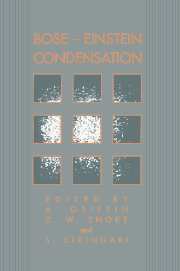Book contents
- Frontmatter
- Contents
- Preface
- Preface to paperback edition
- 1 Introduction: Unifying Themes of Bose–Einstein Condensation
- Part one Review Papers
- 2 Some Comments on Bose–Einstein Condensation
- 3 Bose–Einstein Condensation and Superfluidity
- 4 Bose-Einstein Condensation in Liquid Helium
- 5 Sum Rules and Bose–Einstein Condensation
- 6 Dilute-Degenerate Gases
- 7 Prospects for Bose–Einstein Condensation in Magnetically Trapped Atomic Hydrogen
- 8 Spin-Polarized Hydrogen: Prospects for Bose–Einstein Condensation and Two-Dimensional Superfluidity
- 9 Laser Cooling and Trapping of Neutral Atoms
- 10 Kinetics of Bose–Einstein Condensate Formation in an Interacting Bose Gas
- 11 Condensate Formation in a Bose Gas
- 12 Macroscopic Coherent States of Excitons in Semiconductors
- 13 Bose–Einstein Condensation of a Nearly Ideal Gas: Excitons in Cu2O
- 14 Bose–Einstein Condensation of Excitonic Particles in Semiconductors
- 15 Crossover from BCS Theory to Bose–Einstein Condensation
- 16 Bose–Einstein Condensation of Bipolarons in High-Tc Superconductors
- 17 The Bosonization Method in Nuclear Physics
- 18 Kaon Condensation in Dense Matter
- 19 Broken Gauge Symmetry in a Bose Condensate
- Part two Brief Reports
- Appendix. BEC 93 Participant List
- Index
8 - Spin-Polarized Hydrogen: Prospects for Bose–Einstein Condensation and Two-Dimensional Superfluidity
Published online by Cambridge University Press: 15 December 2009
- Frontmatter
- Contents
- Preface
- Preface to paperback edition
- 1 Introduction: Unifying Themes of Bose–Einstein Condensation
- Part one Review Papers
- 2 Some Comments on Bose–Einstein Condensation
- 3 Bose–Einstein Condensation and Superfluidity
- 4 Bose-Einstein Condensation in Liquid Helium
- 5 Sum Rules and Bose–Einstein Condensation
- 6 Dilute-Degenerate Gases
- 7 Prospects for Bose–Einstein Condensation in Magnetically Trapped Atomic Hydrogen
- 8 Spin-Polarized Hydrogen: Prospects for Bose–Einstein Condensation and Two-Dimensional Superfluidity
- 9 Laser Cooling and Trapping of Neutral Atoms
- 10 Kinetics of Bose–Einstein Condensate Formation in an Interacting Bose Gas
- 11 Condensate Formation in a Bose Gas
- 12 Macroscopic Coherent States of Excitons in Semiconductors
- 13 Bose–Einstein Condensation of a Nearly Ideal Gas: Excitons in Cu2O
- 14 Bose–Einstein Condensation of Excitonic Particles in Semiconductors
- 15 Crossover from BCS Theory to Bose–Einstein Condensation
- 16 Bose–Einstein Condensation of Bipolarons in High-Tc Superconductors
- 17 The Bosonization Method in Nuclear Physics
- 18 Kaon Condensation in Dense Matter
- 19 Broken Gauge Symmetry in a Bose Condensate
- Part two Brief Reports
- Appendix. BEC 93 Participant List
- Index
Summary
Abstract
Spin-polarized atomic hydrogen continues to be one of the most promising candidates for Bose condensation of an atomic system. In contrast to liquid helium, hydrogen is gaseous and therefore its density can be changed to vary its behavior from the weakly to the strongly interacting Bose gas. Until now, efforts to Bose condense hydrogen have been thwarted by recombination and relaxation phenomena. After a long introduction to the subject, two promising approaches to observe quantum degenerate behavior are discussed: the microwave trap and a two-dimensional gas of hydrogen.
Introduction
Since the stabilization of atomic hydrogen as a spin-polarized gas (H↓), reported in 1980 [1], there has been a continuous effort to observe Bose–Einstein condensation (BEC) or other effects of quantum degeneracy in this Bose gas. This challenge has not yet been realized due to the instability of H↓ towards recombination to H2 or relaxation among hyperfine states as the conditions for BEC are approached. Although this difficulty is formidable, hydrogen presents a unique opportunity to study BEC and the related superfluidity, as it remains a gas to T = 0 [2]. By comparison, 4He, the only experimentally observed boson fluid, is a strongly interacting superfluid Bose liquid, with little flexibility for varying its density. As a result of the gaseous nature of hydrogen, its density, n, can be varied over several orders of magnitude with the possibility of studying BEC and its relationship to superfluidity, ranging from the weakly to the strongly interacting boson gas.
- Type
- Chapter
- Information
- Bose-Einstein Condensation , pp. 160 - 172Publisher: Cambridge University PressPrint publication year: 1995
- 3
- Cited by

